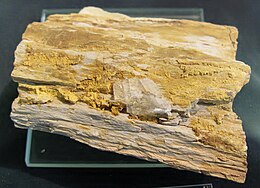
Back Carnotiet Afrikaans كارنوتيت Arabic Карнатыт Byelorussian Carnotita Catalan Carnotit German Καρνοτίτης Greek Carnotita Spanish Karnotita Basque کارنوتیت Persian Carnotite French
| Carnotite | |
|---|---|
 Carnotite in fossilized wood from St. George, Utah | |
| General | |
| Category | Vanadate mineral |
| Formula (repeating unit) | K2(UO2)2 (VO4)2·3H2O |
| IMA symbol | Cnt[1] |
| Strunz classification | 4.HB.05 |
| Crystal system | Monoclinic |
| Crystal class | Prismatic (2/m) (same H-M symbol) |
| Space group | P21/a |
| Unit cell | a = 10.47 Å, b = 8.41 Å, c = 6.91 Å; β = 103.83°; Z = 2 |
| Identification | |
| Color | Bright yellow to lemon-yellow, may be greenish yellow. |
| Crystal habit | Crusts, earthy masses, foliated and granular aggregates. |
| Twinning | On {001} as both twin and composition plane |
| Cleavage | Perfect on {001}, micaceous |
| Fracture | uneven |
| Mohs scale hardness | 2 |
| Luster | Dull, earthy; silky when crystalline |
| Streak | yellow |
| Diaphaneity | Semitransparent |
| Specific gravity | 4.70 |
| Optical properties | Biaxial (−) |
| Refractive index | nα=1.750 – 1.780, nβ=1.901 – 2.060, nγ=1.920 – 2.080 |
| Birefringence | δ = 0.200 |
| 2V angle | Measured: 43° to 60°, Calculated: 26° to 36° |
| Other characteristics | |
| References | [2][3][4][5][6] |
Carnotite is a potassium uranium vanadate radioactive mineral with chemical formula K2(UO2)2(VO4)2·3H2O. The water content can vary and small amounts of calcium, barium, magnesium, iron, and sodium are often present.
- ^ Warr, L.N. (2021). "IMA–CNMNC approved mineral symbols". Mineralogical Magazine. 85 (3): 291–320. Bibcode:2021MinM...85..291W. doi:10.1180/mgm.2021.43. S2CID 235729616.
- ^ Mineralienatlas
- ^ Handbook of Mineralogy
- ^ Hurlbut, Cornelius S.; Klein, Cornelis, 1985, Manual of Mineralogy, 20th ed., John Wiley and Sons, New York ISBN 0-471-80580-7
- ^ Mindat.org
- ^ Webmineral
© MMXXIII Rich X Search. We shall prevail. All rights reserved. Rich X Search